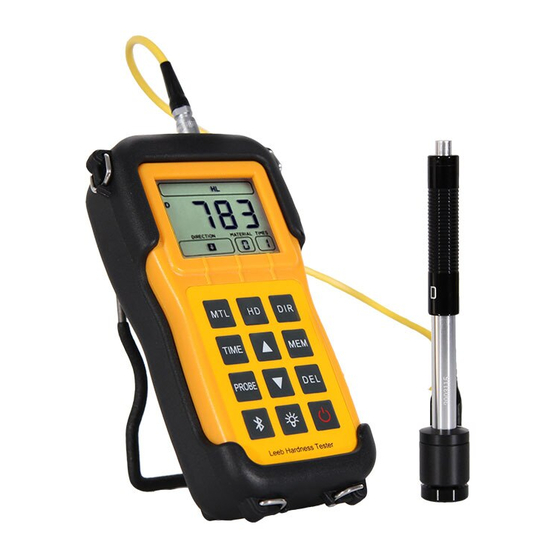
Table of Contents
Advertisement
Quick Links
CONTENT
1.Principle of Leeb hardness testing method .............................................. 1
2. Summary ................................................................................................... 2
2.1 LM-100 ............................................................................................. 2
2.2 D type impact device ....................................................................... 3
2.3 Type of Impact Devices ................................................................... 4
2.4 Impact devices introduction: .......................................................... 4
2.5 Standard delivery: ........................................................................... 5
2.6 Optional accessories: ...................................................................... 6
3. Functions and Applications ...................................................................... 7
3.1 Technical Specifications .................................................................. 7
3.2 Applications ..................................................................................... 7
4 .Pre-Treatment of Workpiece .................................................................... 8
4.1 Workpiece Requirements ............................................................... 8
4.1.1 Surface Roughness requirements ....................................... 8
4.1.2 Weight and Thickness Requirements ................................. 8
4.1.3 Surface Hardened Layer ..................................................... 8
4.1.4 Curved surface Requirement .............................................. 8
4.2 Support of Test piece ....................................................................... 9
5. Operation ................................................................................................... 9
5.1 Display.............................................................................................. 9
5.2 Keyboard ....................................................................................... 10
5.3 Turn on the instrument ................................................................. 10
5.4 Parameters Setting ........................................................................ 10
5.4.2 Hardness Scale ................................................................... 11
5.4.3 Impact devices .................................................................... 11
5.4.5 Average times ...................................................................... 11
5.6 Average value ................................................................................. 12
5.7 Data save and read settings .......................................................... 12
5.7.1 Storage testing result .......................................................... 12
5.7.2 Reading ................................................................................ 13
5.7.3 Delete ................................................................................... 13
5.8 Blue tooth and print ...................................................................... 13
5.9 Calibration (Error-correction settings) ....................................... 14
6. Maintenance & servicing ........................................................................ 14
Advertisement
Table of Contents

Summary of Contents for YUSHI LM-100
-
Page 1: Table Of Contents
1.Principle of Leeb hardness testing method ..........1 5.7.2 Reading ................13 2. Summary ....................2 5.7.3 Delete ................... 13 2.1 LM-100 ..................... 2 5.8 Blue tooth and print ..............13 2.2 D type impact device ............... 3 5.9 Calibration (Error-correction settings) ........14 2.3 Type of Impact Devices .............. -
Page 2: Principle Of Leeb Hardness Testing Method
2. Summary The impact body, which is equipped with tungsten carbide, impacts into the 2.1 LM-100 work piece and rebounds back. The rebound and impact velocities are measured at the 1mm point from the work piece in the following way: the integrated permanent magnet will produce directly proportional voltage with the impact velocity. -
Page 3: D Type Impact Device
2.2 D type impact device 2.3 Type of Impact Devices 2.4 Impact Devices Specification: Special Impact D/DC/DL D+15 Device 11mJ 11mJ 11mJ 11mJ 11mJ Impact Energy Mass of Impact Body 5.5g/7.2g 7.8g 3.0g 20.0g 5.5g Test Tip Hardness 1600HV 1600HV 1600HV 1600HV 5000HV... -
Page 4: Standard Delivery
Coupled 》0.8mm 》0.8mm 》0.2mm 》1.2mm 》0.8mm 2.6 Optional accessories: Min. thickness of layers Indentation of test tip Impact device DC/C/DL/D+15/G With Diameter 0.54mm 0.54mm 0.38mm 1.03mm 0.54mm Standard Calibration Test Block 300HV Depth 24μm 24μm 12μm 53μm 24μm ... -
Page 5: Functions And Applications
3. Functions and Applications 4 .Pre-Treatment of Workpiece 3.1 Technical Specifications 4.1 Workpiece Requirements Measuring Method: Leeb Hardness Testing method Hardness Scale: HL, HB, HRB,HRC,HV,HS, σ 4.1.1 Surface Roughness requirements Measuring Range : HLD (200-960) HRC(19.8-68.5) HB(30-651) HV Surface roughness is an important requirement for the surface of the test piece, (80-976)... -
Page 6: Support Of Test Piece
5.2 Keyboard 4.2 Support of Test piece The heavy workpiece do not need support The Mid-heavy workpiece must be placed on a flat, sturdy surface, and absolutely smooth placement, without any shaking. 5.3 Turn on the instrument Light workpiece must be tightly coupled with the solid support body, the coupling surface must be smooth, and Coupled dosages don’t too much, Press to power on the LM100, the screen will display the default interface... -
Page 7: Hardness Scale
After testing, the tester will display as following: 5.4.2 Hardness Scale Press “HD” to choose the Hardness scale and strength: 5.4.3 Impact devices Press “Probe” button to select probes. 5.4.4 Impact Direction Press “DIR” button to select impact direction 5.5.2 Reject the Gross Error Value During the measuring process, if the deviation between the measured value and 5.4.5 Average times... - Page 8 on the screen. 5.9 Calibration (Error-correction settings) The tester will save testing results automatically, including 7 testing results and 1 average value each group, and total 100 groups can be stored. Measuring error can be usually caused by test tip abrasion or changing another Note: Please store the data by pressing the “MEM”...

Need help?
Do you have a question about the LM-100 and is the answer not in the manual?
Questions and answers